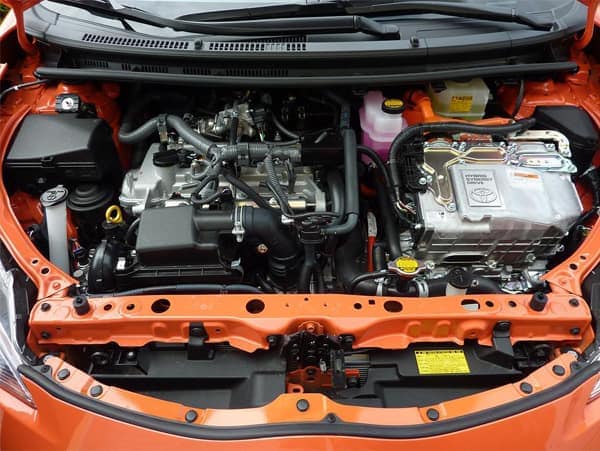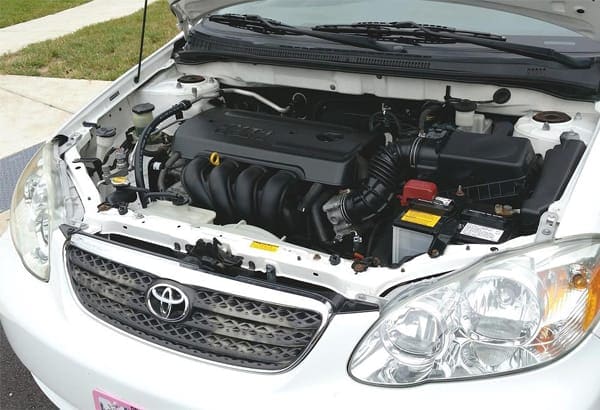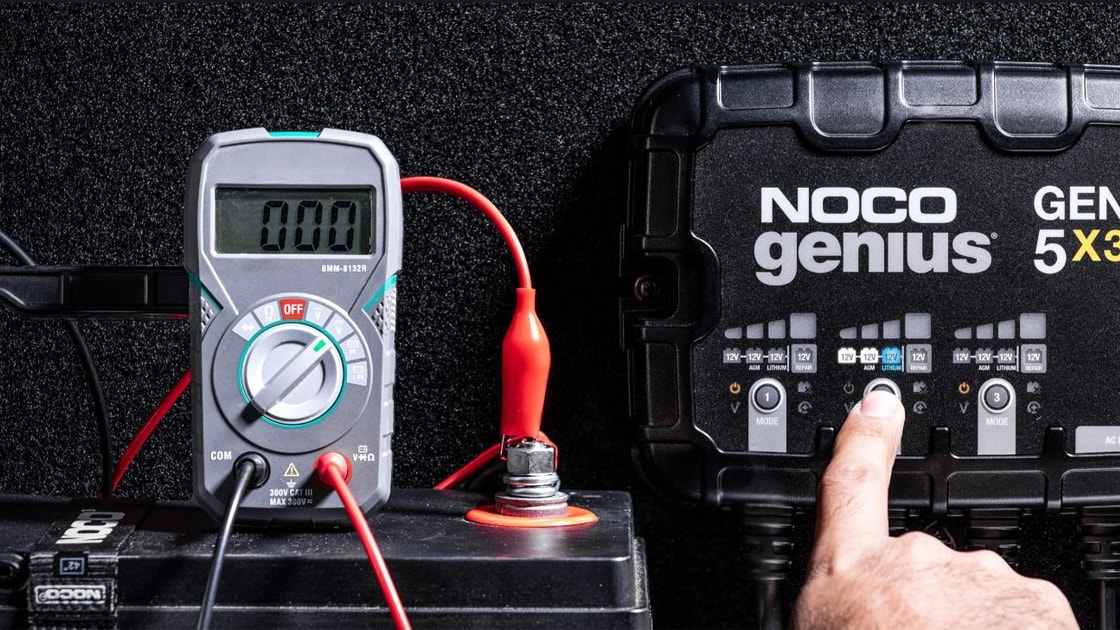The battery is a very important component of automobiles. If your car battery runs down, you will get into many troubles and inconveniences.
Therefore it is very important to regularly keep track of the battery lifespan for in-time maintenance and replacement. When the battery wears off, you cannot start the engine and have to recharge it with a battery charger.
However, overcharging the battery is very dangerous as it may cause flame or explosion. So you need to learn how to read battery charger amp meters.
This post will shine more light on this topic and give you detailed instructions on correctly reading the battery charger ammeter. Continue reading to find out!
What Is The Battery Charger Amp Meter?
To understand what the meters do, we first need to take a look at the car battery chargers. Your car charging cell may run out of power without regular charging or maintenance, and the engine cannot start.
You will need to use the battery chargers, a common tool that can recharge the battery through a strong electrical current. The battery amp meter is integrated into the tool, usually on the charger’s side.
It indicates how much your vehicle battery has been charged and helps you measure the electrical current produced by the charger. There are three main types of meters: Direct current (DC), meter mounted, and external shun.
This item helps prevent overcharging and reduces the risk of an explosion or the engine catching fire. Overcharging happens when you use a charger with a too-high amp rating for the vehicle, or you charge it for too long.
The ammeter is prevalent on many regular charging tools, while modern chargers have safety features that automatically shut off the charging and regulate the voltage to match your vehicle.
So these tools don’t need an ammeter. But if you are using classic chargers, it is very important to read the built-in ammeter to use the tool correctly.

What to do with dead batteries?
Types Of Car Battery Chargers
There are many types of car battery chargers with different voltages that are suitable for a specific vehicle type. Here are some common examples:
- 40 amp chargers: With the high voltage, it can charge your car battery very fast and efficiently. The 40 amp charger can revive a dead battery in only a few minutes.
- 10 amp chargers: These chargers are commonly used to maintain and recharge the batteries when not in use rather than kick-starting the dead ones. It can fully recharge a dead battery in between 8 – 14 hours.
- 4 and 2-amp chargers: These tools don’t work with large vehicles due to their small voltage. It is commonly used for small cars and motorcycles, which are very light and portable to carry around. The charging time can take up to a whole day.
How To Read Battery Charger Amp Meter?

Amp meter for battery chargers
So I have discussed the importance of reading the battery charger with the meter. Now let’s jump into the right method to read the ammeter correctly.
A common amp meter involves three main factors: the charge rate, the percent charged, and finally, the red and green triangles. Each component indicates a specific thing, so you have to understand them thoroughly.

Check the battery carefully before charging
Charge Rate
It is located at the bottom of the ammeter, showing various numbers of amps on the charger model. The number is generally from 0 to 12.
Percent Charged
You can find the percent charged on top of the charge rate. It indicates how much percentage of your battery has been filled, with a needle moving from left to right showing that the amps are decreasing.
The higher the percent charged, the closer the needle moves to the right, which indicates that the amps have decreased to near zero.

Schumacher Ammeter Horizontal 0-12 AMP
Red and Green Triangles
You will see two separate parts of red and green triangles in a rectangular. The red triangle indicates the amount of amp running from the chargers to the cell, which will decrease over time.
When the flow rate decreases, the needle will gradually move to the left or the green part of the rectangular. There’s another red triangle that shows the amps running between the settings of the chargers.
So I have covered the basic parts of the amp meter. Now we will move on to the detailed instructions to read the tool correctly. Before reading the amp meter, you first need to connect the chargers to the battery.

Battery charging process
How To Connect A Battery Charger?
Follow these instructions to use the device properly.
Step 1: Put on protective gloves or goggles in case the battery explodes, or the electricity is leaked out.
Step 2: Turn off the car engine and all electrical gadgets. Then disconnect the power cable.
Step 3: Turn off the device when you connect it to the battery.
Step 4: Pair the positive clip with the battery’s positive terminal and do the same for the negative clip and terminal. A positive terminal will be in red; the negative one is black. If you are not sure, read the owner’s manual.
Step 5: Power on the charger after settling the needles. It will automatically charge the battery; you will see the needle moving on the amp meter.
If you want more in-depth instructions, consider watching the video below.
What To Do Before Connecting The Charger To The Battery?
Remember to clean the tool with water or baking soda to remove the dust and corrosion. Rusty chargers may leak sulfuric acid. Use a toothbrush and clean it gently to not damage the terminal.
Don’t put the charger too close to the car battery in case it emits sulfuric acid and damages your engine. Some old chargers will have different voltage levels, which you must adjust carefully to match the car battery.
If you can’t find the adjust button, read the owner’s manual carefully before using it. A high-end ammeter battery charger automatically adjusts the voltage to match the charged battery.
Before connecting, check the current state of both the charger and battery thoroughly. If there is any external damage, you should leave it alone. Damaged batteries can explode or catch fire easily, which is very dangerous.
If you have taken the charging cell out of the car, remember to pair the ground cable with a more than 24 inches long jumper. Finally, connect this cable to the clamp. This method will reduce the risk of explosion.

Connecting the terminals to the clamps
Related:
- What Is Car Battery Voltage? – For A Healthy Vehicle
- How To Read Car Battery Date Codes? A Simple And Detail Instruction
- A Detailed Guide On How To Test Batteries With A Multimeter
What To Note When Reading a Battery Charger Amp Meter?
When you turn on the chargers, and they begin charging, the needles may move up and down very fast. Don’t worry because your device is working totally fine; it takes a few seconds to settle down.
Wait for the needles to settle down, and they will indicate the exact number of amps and charged percentage. If you see a sharp drop in the ammeter, the device is producing the maximum energy output.
If the needles keep jumping instead of settling down, it’s a sign that the connection between the clip and terminal is loose. Another reason is that your battery may be defective.
If the charger doesn’t work, check if your car battery is covered with dirt or has any external damage. The needles may get stuck on some old chargers due to the dirt.
You can reduce the amp of the chargers manually for more safety. Increase the amp if you’re short on time. Some old chargers won’t turn off automatically when the battery is fully charged.
So it is best to manually turn off the chargers. Read the manual script to know if your device supports this function.
FAQS
How Many Amps Do Battery Chargers Need?
The amps on the chargers should not be less than one-tenth of the vehicle battery. For example, if your automobile has a 200Ah battery, you need a charger with at least 20 amps.
The higher the amp, the faster the device will charge your battery. Generally, larger vehicles such as trucks or cars only work with powerful chargers. Meanwhile, if you are using a motorcycle, a 2-10 amp charger is sufficient.
How To Know When The Battery Is Fully Charged?
The battery is fully charged when the needle on the amp meter reaches six amps with a load setting of 12 amps. For the 2 amp battery charger, the needle will reach near the end of the smaller red triangle.
If you use a voltmeter, the battery is fully charged when the tool shows at least 12.6 volts.
Should You Disconnect The Battery When Charging?
It is doable to disconnect the charger when it is charging the battery. You will want to do it for more convenience and save time. Also, you don’t need to remove the battery from the car; just charge it directly using the chargers.
However, it is best to remove the battery and clean it thoroughly to ensure your safety. Remember to disconnect the negative terminals first to avoid getting electrical shocks, which are very dangerous.
Before disconnecting the battery, don’t forget to turn off the radio, speakers, lights, and other electrical gadgets in the car.
Should I Use a 2 Amp Or 10 Amp Charger?
It depends on the battery size of your vehicle and how long you want to charge. A 2 amp charger is generally safer due to its small voltage, but they take a long time to fully charge the batteries.
10 amp or more powerful chargers, on the other hand, can charge the batteries very fast. They are suitable for jumpstarting dead batteries in urgent situations.
Final Thoughts
I hope that the detailed information and instructions provided in this post can satisfy you. Dealing with electrical devices and batteries is dangerous, so ensure that you follow the instructions carefully to avoid any unwanted problems.
Did this post help you read the battery charger meter successfully? Feel free to comment below and share with me your opinion.
Thank you for reading!
WHAT'S NEW
The best AGM battery chargers will be the ideal option to revive your flat battery without relying on professional help. These handy high-tech chargers are extremely beneficial because they offer...
The Genius Boost GB40 is popular because of its ability to help boost your vehicle when it has battery issues. Many of our customers wonder why the Noco GB40 can work greatly like so. So, we have...

